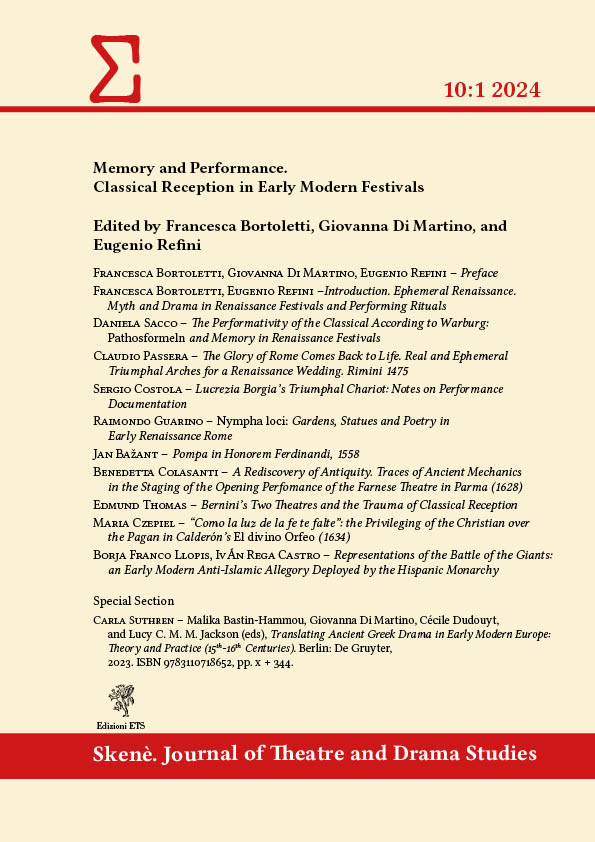A Rediscovery of Antiquity. Traces of Ancient Mechanics in the Staging of the Opening Perfomance of the Farnese Theatre in Parma (1628)
DOI:
https://doi.org/10.13136/r2ewn909Abstract
When studying Baroque theatre, which was characterized by surprising scene changes and mechanical movements, we cannot ignore ancient mechanics. In the sixteenth century, we can observe that the Renaissance city and its symbolic monuments were represented in perspective in the court theatres. Perspective rigor, scenic metamorphosis and mechanical wonder coexisted on stage; the latter were a point of arrival (and also a new starting point) of a tradition that, starting from antiquity, seems to have continued into the seventeenth century. When we study the machines of the inaugural performance of the Farnese Theatre in Parma – Mercurio e Marte (1628) – and the sources related to it, we easily come across the knowledge of the ancient heritage. The anonymous treatise Il corago (1628-1637) offers entire chapters from Julius Pollux’s Onomasticon translated into the vernacular, and in his Pratica (1638) Nicola Sabbatini, like Heron, recommends oiling the machines in order to achieve a more fluid movement. Literary and iconographic documents also refer to machines already described by Vitruvius, Pollux and Heron of Alexandria: the cranes for suspending gods or other figures, the ‘staircase of Charon’ for access to the corridors between the stage and the under-stage, various systems for scene changes. By overlapping the sources for the study of the inaugural performance of the Farnese Theatre, the seventeenth-century treatises and the ancient treatises, this article aims to identify the ancient machineries still valid in Mercurio e Marte and in the Baroque theatre; it also aims to evoke a tradition of transmission of knowledge among mechanics that, starting from antiquity, extends directly into modern times, partially denying the extemporaneous ‘rediscovery’ of antiquity.
Keywords: rediscovery of antiquity; stage machinery; Farnese Theatre; scenery; set design
Downloads
Published
Issue
Section
License
Copyright (c) 2024 Skenè. Journal of Theatre and Drama Studies

This work is licensed under a Creative Commons Attribution 4.0 International License.
Open Access Policy
This journal provides immediate open access to its content on the principle that making research freely available to the public supports a greater global exchange of knowledge.
This Journal is a CC-BY 4.0 publication (https://creativecommons.org/licenses/by/4.0/). This Licence allows others to share the work with an acknowledgement of the work’s authorship and initial publication in this Journal, providing a link to the Licence and explicitly underlining any change (full mention of Issue number, year, pages and DOI is required).
- The Author retains (i) the rights to reproduce, to distribute, to publicly perform, and to publicly display the Article in any medium for any purpose; (ii) the right to prepare derivative works from the Article; and (iii) the right to authorise others to make any use of the Article so long as the Author receives credit as Author and the Journal in which the Article has been published are cited as the source of first publication of the Article. For example, the Author may make and distribute copies in the course of teaching and research and may post the Article on personal or institutional Web sites and in other open-access digital repositories.
- The Author is free to enter into separate, additional contractual arrangements for the non-exclusive distribution of the Journal’s published version of the work, with an acknowledgement of its initial publication in this Journal and explicitly underlining any change (full mention of Issue number, year, pages and DOI is required).
- The Author is permitted and encouraged to post their work online after the evaluation process has been successfully passed, as it can lead to productive exchanges as well as to a wider dissemination of the published work.

